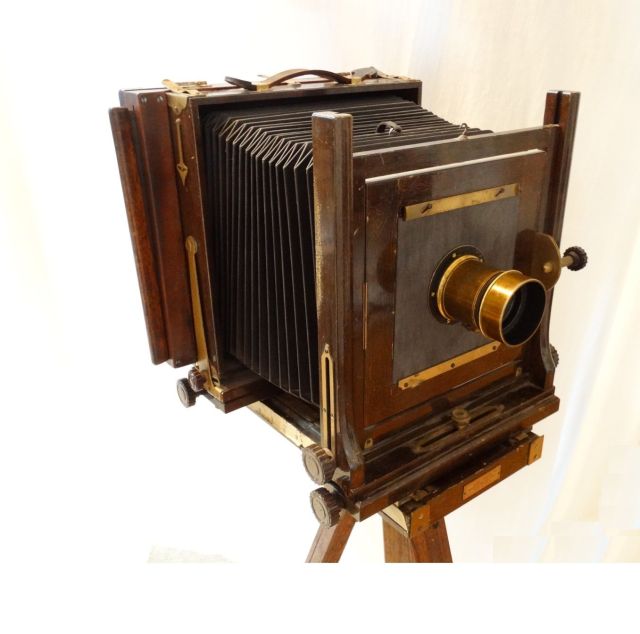Working in the field with the Wet Collodion process provides interesting challenges, everything from the weather, temperatures and even microclimates can cause the chemicals to be fussy and not work correctly, I’ve had days and even weekends when my chemicals just didn’t want to work.

The next problem, the general public, even after explaining the process, that I need to develop or transfer the sensitized plate, to the plate holder in dark room like conditions, they ask or even mistake my portable darkroom as a camera. This has caused me to move my dark-box to a less prominent area of my camp.
__________________
The Portable Dark Room, these came in many different designs, some were small carts, others were wagons, small tents, with others being wooden boxes of various types of configurations.
The photographer could actually purchase, what was often simply referred to as a Dark-tent, or Dark-box. Our Dark-box has evolved, some, starting with a wooden box with a window to allow light inside.

The Design was loosely designed was based upon a dark-box that is crafted by Black Art Woodcraft.
Our Design even used a similar design stand, which proved to be unstable in part because of my physical height, and a requirement to have the dark box internal work surface as a high a the counters in Julie child’s kitchen.
The Next question I do get once in a while is did you make it? No, I didn’t make the box, at the time I didn’t have the skills. however, I did design it and finish it. My skills with regards to woodworking were limited primarily to finishing work. so, I stained, the exterior, painted in the interior, added the handles. the shroud, and support for the shroud.

I choose the yellow, as it’s bright, allowing better visibility within the dark-box, as well as being a color that collodion film is blind too. I eventually painted my entire darkroom the same yellow. Also, yellow was the color traditionally used within dark-boxes 
This is one of the few surviving portable dark-boxes from the 19th century, I’m not sure it was ever actually used as silver nitrate tends to eat wood, and get on everything. Style of dark-box, I call the suitcase style, when it’s closed, it resembled a suitcase

As the original stand to our Dark-box provided to be unstable, I and with a realization that many dark-boxes were supported by a tripod I began designing a new stand. – note the dark-box in the image, it’s more of the suitcase style, but it supported by a tripod support.

Here’s another modern dark-box designed like the suitcase style, built as I understand it by Mark Osterman and later sold to the photographer using it. this photo was taken 20+ years ago when collodion artist where activity working at reenactments.

Interesting note about her garb is that she’s wearing a long coat, this style coat almost seemed to be the in style for a photographer of the period working in the field that along with a basic straw hat. Mathew Brady, Timothy O’Sullivan, and even Alexander Gardner have been photographed wearing similar coats in the field.
back to our Dark-box, the opportunity presented itself, Ty Guillory, on his page Guillory Cameras was selling plans for a platform tripod. I purchased the plans and adapted them for use with my Dark-box, recreating the cleat design in the bottom of the tripod, then adding a conventional sized mounting bolt in the bottom of the dark box, this allows me to effectively use a single bolt to attach the dark-box to the tripod, while preventing it from twisting on the platform.

the top is made from solid cherry – a board that I fell in love with because of the grain that I found at the store specializing in hardwood, the legs are made from oak. The next aspect was after looking at my Zone IV wood tripod, I noticed it had two sets of bolts for the lower extension of the leg, so, I simply added another set. this prevents the leg from collapsing.
So, with the exception of smooth or slippery surfaces, tripod support is extremely solid, when used in conditions where I have smooth or slippery surfaces I either drive a stake in the ground at the end of each leg, or I use anti-skid mats under each leg.
our Darkbox is ideal for the whole plate sized plates but becomes a little tight for 8×10, it’s also not particularly portable, I’m working on a couple of different design idea for more portability, and would eventually like to build or purchase a cart such as the one Barbara L. Stevenson uses. This I feel would allow me to move my camera around to different locations at events, working more as an itinerant photographer. 
here are some different photo’s & drawings of dark tents, boxes, carts, and wagons.
So, is the Dark Box a Camera.. no, it’s literary just a big wooden box used as my portable dark room, the only things that my dark box has in it when it’s setup is maybe a tray, some bottles, paper towels and a bunch of silver stains. I did add a couple of strips of LED lights hidden in the top for extra lighting when using it indoors.























 Historically, there are many different designs to choose from as exemplified in catalogs, photographs and a small handful remaining of historic examples.
Historically, there are many different designs to choose from as exemplified in catalogs, photographs and a small handful remaining of historic examples.




































